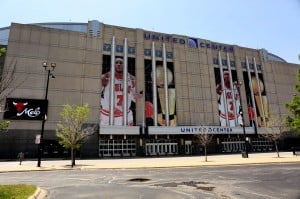The Chicago Blackhawks and Chicago Bulls faced very different situations this summer.

The Bulls created an elaborate presentation at the United Center as they tried to lure Carmelo Anthony away from the New York Knicks while the Chicago Blackhawks offered some of their best players to other teams. The core reason for these differences was the accuracy of salary cap forecasting within the specific leagues.
The NHL fell victim to bad forecasting in 2014. Early in the year, the commissioner predicted a $71.1 million salary cap for the upcoming season. General Managers across the league began to plan their roster moves accordingly. It wasn’t until months later, when the actual figures came in, that the league realized it had overestimated the growth of the revenues; the hard salary cap would instead only be $68 million. The $3.1 million difference didn’t affect teams that conservatively reacted to the forecast, but teams like the Blackhawks found themselves needing to eliminate nearly $3 million worth of payroll. So as the team practiced all summer, the atmosphere was not one of anticipation and excitement but rather apprehension, knowing a significant player would need to be traded. Ultimately, Nick Leddy lost his spot on a championship team because the league falsely predicted the growth of their revenues.

In contrast, the NBA did not suffer from bad forecasting. They were not perfectly accurate, as is expected, but they conservatively expected a 4.5% increase. By not relaying an unrealistic expectation to the general managers, the league prevented premature dealings by teams. Plus, on three separate occasions throughout the year, the league adjusted their forecast to improve its accuracy. The eventual salary cap was a 7.7% increase from the previous year. This left the Chicago Bulls with extra, unexpected cap space to try to recruit top free agents—a much preferable problem than having to shed payroll.
General Managers have to find the balance between optimistic forecasts and reality. The NHL should’ve considered the effect of the lockout shortened season as well as the decline of the Canadian dollar when they predicted a forecast that followed the record growth trend from previous years. The NBA did a much better job of using environmental signs such as market values of sold teams to predict their league growth. In the years to come, I’d expect NHL managers to be more hesitant in relying on initial forecasts, and perhaps adopt NBA strategies in approaching salary cap forecasts.

The salary cap in certain leagues is an absolute maximum accompanied by severe penalties for violations. It makes it even more consequential when a forecast is overestimated. Some teams will wait until the cap is released to sign players while other teams sign players based on forecasts. It poses the question: Which is the preferred scenario? New York Jets fans are currently complaining because their team lacks talent despite having nearly $20 million in cap space to be spent while Blackhawks fans were upset with having to trade Leddy in order to be under the cap. Which scenario would you prefer your favorite team be in? Do you rely on the forecast and deal with the consequences of inaccuracy or wait until the actual cap is set to make important decisions and risk missing out on top talent?
Sources:
http://espn.go.com/nba/story/_/id/10808291/nba-salary-cap-projected-rise-nearly-5-million
Images: Capgeek.com